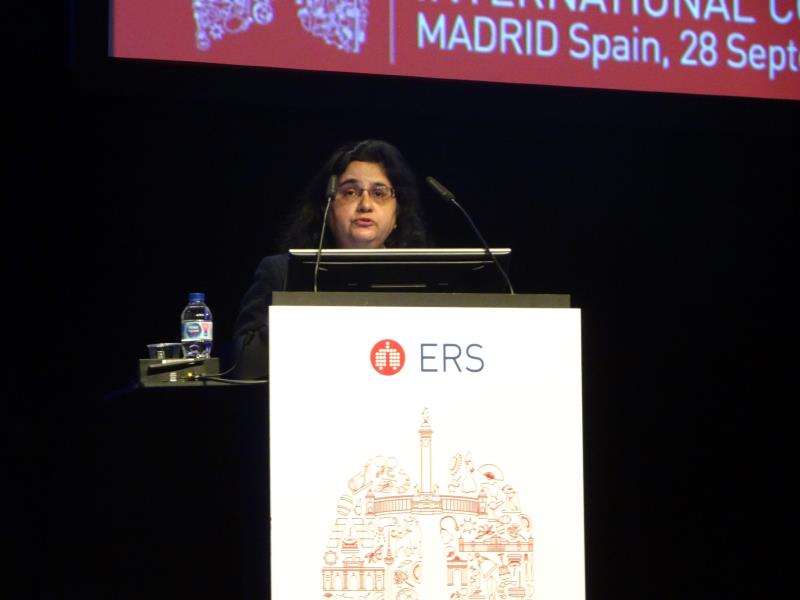 Dr Rekha Chaudhuri
Dr Rekha ChaudhuriBronchial thermoplasty (BT) provided sustained improvements in patients with severe asthma, according to the results of the BT10+* study presented at ERS 2019.
“[The] improvements in asthma control after BT are durable for ≥10 years after treatment,” said study investigator Dr Rekha Chaudhuri from the University of Glasgow in Glasgow, UK, who presented the findings.
BT is a device-based endoscopic treatment for persistent severe asthma that is not well-controlled with usual treatment (ie, inhaled corticosteroids, long-acting beta-agonists). It utilizes a radiofrequency energy delivered to the airway walls through a bronchoscope. [BMC Pulm Med 2011;11:8]
“In the [Asthma Intervention Research (AIR)] study, the most interesting thing was … the improvement in peak flow and asthma control 3 months after [BT]. What we did not expect however was [the sustained effect] a year after the treatment,” said Chaudhuri. In AIR 2, the reduction in exacerbations and emergency room (ER) visits were sustained up to 5 years after BT. These benefits could be due to the reduction in the airway smooth muscle and subepithelium along the airway wall, noted Chaudhuri. [Clin Exp Allergy 2019;49:541-544; J Allergy Clin Immunol 2017;139:1176-1185]
After observing a sustained pattern of efficacy up to 5 years in the above trials, the investigators sought to evaluate the longer-term efficacy and safety of BT in participants (n=136; mean age 53.6 years, 60.3 percent female) from the AIR, AIR2, and Research in Severe Asthma trials. Participants should be void of severe asthma exacerbation or chest infection within a month preceding enrolment. [ERS 2019, abstract RCT 3782]
At 10 years, the incidence of severe asthma exacerbations was significantly reduced from baseline** (p<0.05). “[The] reduction in the number of patients having exacerbations [was already seen] at 1 year, and this was sustained up to 10 years,” said Chaudhuri.
There was also a significant reduction in healthcare utilization among BT recipients at 10 years compared with baseline (p<0.05 for both hospitalization and ER visits). The reductions were evident as early as 1 year, noted Chaudhuri. Although the 10-year ER visits were higher than year 1, it was substantially lower than baseline, noted Chaudhuri. For hospitalization, despite the similarities between the 5- and 10-year results, the current findings were also “better than baseline”, she added.
Improvements in the Asthma Quality-of-Life Questionnaire (AQLQ) and Asthma Control Questionnaire (ACQ) scores manifested as early as 3 months following initial BT use, which was also sustained up until 10 years, noted Chaudhuri.
Safety-wise, lung function remained stable from the baseline FEV1*** measurements (percent predicted) of 72.9 (pre-salbutamol) and 79.4 (post-salbutamol), with no significant reduction over 10 years.
High-resolution computed tomography scan revealed that 13.4 percent of BT recipients had evidence of bronchiectasis at the 10-year visit. However, when the baseline scans were reviewed, only 6.3 percent of BT recipients had new evidence of bronchiectasis and most of these were mild, Chaudhuri pointed out.
“Bronchiectasis is an occasional finding in CT scans 10 years following BT,” she added.
Taken together, the findings suggest the durable efficacy and safety of BT beyond 10 years with no significant effect in lung function, said Chaudhuri.